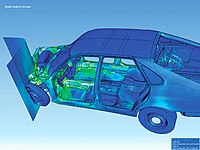
Photo from wikipedia
BackgroundRapid maxillary expansion (RME), indicated in the treatment of maxillary deficiency directs high forces to maxillary basal bone and to other adjacent skeletal bones. The aim of this study is… Click to show full abstract
BackgroundRapid maxillary expansion (RME), indicated in the treatment of maxillary deficiency directs high forces to maxillary basal bone and to other adjacent skeletal bones. The aim of this study is to (i) evaluate stress distribution along craniofacial sutures and (ii) study the displacement of various craniofacial structures with rapid maxillary expansion therapy by using a Finite Element model.MethodsAn analytical model was developed from a dried human skull of a 12 year old male. CT scan images of the skull were taken in axial direction parallel to the F-H plane at 1 mm interval, processed using Mimics software, required portion of the skull was exported into stereo-lithography model. ANSYS software was used to solve the mathematical equation. Contour plots of the displacement and stresses were obtained from the results of the analysis performed.ResultsAt Node 47005, maximum X-displacement was 5.073 mm corresponding to the incisal edge of the upper central incisor. At Node 3971, maximum negative Y-displacement was -0.86 mm which corresponds to the anterior zygomatic arch, indicating posterior movement of craniofacial complex. At Node 32324, maximum negative Z-displacement was -0.92 mm representing the anterior and deepest convex portion of the nasal septum; indicating downward displacement of structures medial to the area of force application.ConclusionsPyramidal displacement of maxilla was evident. Apex of pyramid faced the nasal bone and base was located on the oral side. Posterosuperior part of nasal cavity moved minimally in lateral direction and width of nasal cavity at the floor of the nose increased, there was downward and forward movement of maxilla with a tendency toward posterior rotation. Maximum von Mises stresses were found along midpalatal, pterygomaxillary, nasomaxillary and frontomaxillary sutures.
Journal Title: Progress in Orthodontics
Year Published: 2017
Link to full text (if available)
Share on Social Media: Sign Up to like & get
recommendations!